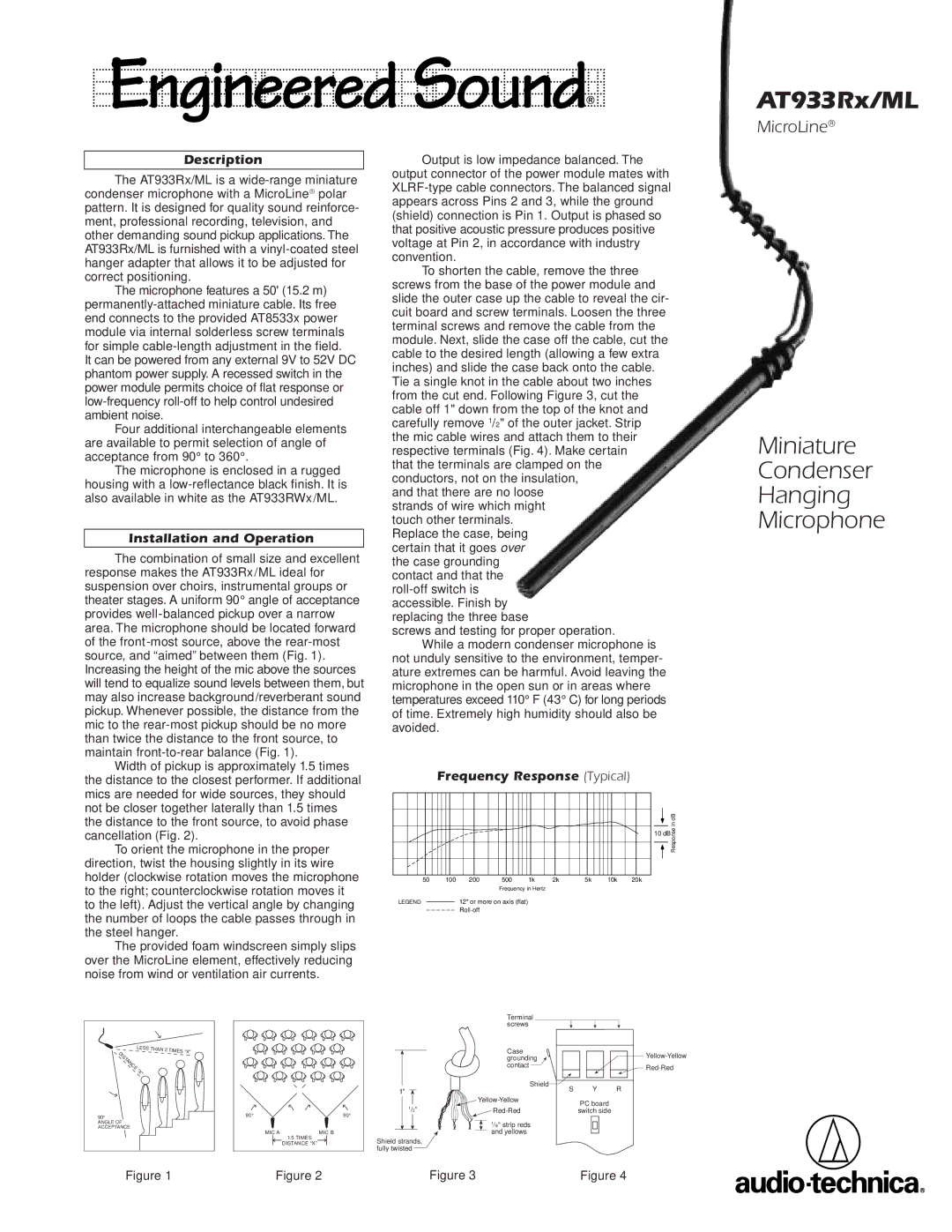
Description
The AT933Rx/ML is a
The microphone features a 50' (15.2 m)
It can be powered from any external 9V to 52V DC phantom power supply. A recessed switch in the power module permits choice of flat response or
Four additional interchangeable elements are available to permit selection of angle of acceptance from 90° to 360°.
The microphone is enclosed in a rugged housing with a
Installation and Operation
The combination of small size and excellent response makes the AT933Rx/ML ideal for suspension over choirs, instrumental groups or theater stages. A uniform 90° angle of acceptance provides
Width of pickup is approximately 1.5 times the distance to the closest performer. If additional mics are needed for wide sources, they should not be closer together laterally than 1.5 times the distance to the front source, to avoid phase cancellation (Fig. 2).
To orient the microphone in the proper direction, twist the housing slightly in its wire holder (clockwise rotation moves the microphone to the right; counterclockwise rotation moves it to the left). Adjust the vertical angle by changing the number of loops the cable passes through in the steel hanger.
The provided foam windscreen simply slips over the MicroLine element, effectively reducing noise from wind or ventilation air currents.
Output is low impedance balanced. The output connector of the power module mates with
To shorten the cable, remove the three screws from the base of the power module and slide the outer case up the cable to reveal the cir- cuit board and screw terminals. Loosen the three terminal screws and remove the cable from the module. Next, slide the case off the cable, cut the cable to the desired length (allowing a few extra inches) and slide the case back onto the cable. Tie a single knot in the cable about two inches from the cut end. Following Figure 3, cut the cable off 1" down from the top of the knot and carefully remove 1/2" of the outer jacket. Strip the mic cable wires and attach them to their respective terminals (Fig. 4). Make certain
that the terminals are clamped on the conductors, not on the insulation, and that there are no loose strands of wire which might
touch other terminals. Replace the case, being certain that it goes over the case grounding contact and that the
screws and testing for proper operation.
While a modern condenser microphone is not unduly sensitive to the environment, temper- ature extremes can be harmful. Avoid leaving the microphone in the open sun or in areas where temperatures exceed 110° F (43° C) for long periods of time. Extremely high humidity should also be avoided.
| Frequency Response (Typical) |
|
| ||||||
|
|
|
|
|
|
|
|
| in dB |
|
|
|
|
|
|
|
| 10 dB | Response |
50 | 100 | 200 | 500 | 1k | 2k | 5k | 10k | 20k |
|
|
|
| Frequency in Hertz |
|
|
|
|
| |
LEGEND |
| 12" or more on axis (flat) |
|
|
|
|
|
| |
|
|
|
|
|
|
|
|
| |
AT933Rx/ML
MicroLine®
Miniature
Condenser
Hanging
Microphone
| LESS |
|
DISTANCE | THAN 2 | TIMES “X” |
“X” |
| |
|
| |
90° |
|
|
ANGLE OF |
|
|
ACCEPTANCE |
|
|
90° | 90° |
MIC A | MIC B |
| 1.5 TIMES |
| DISTANCE “X” |
Terminal screws
Case grounding contact
Shield
1"
1/2"Red-Red
1/8" strip reds
and yellows
Shield strands, fully twisted
S Y R
PC board
switch side
Figure 1 | Figure 2 | Figure 3 |
Figure 4
